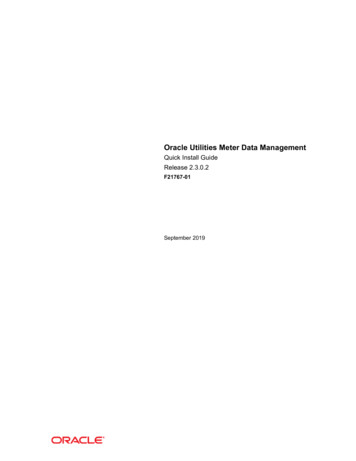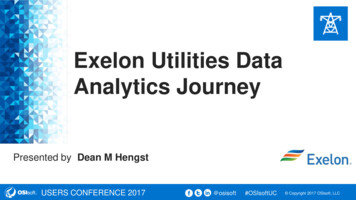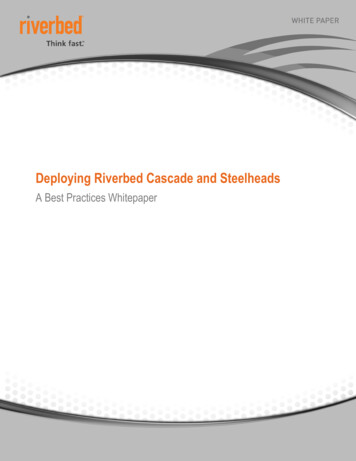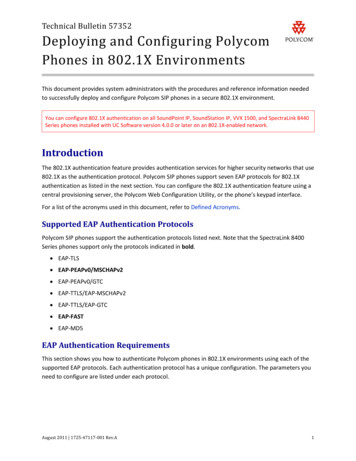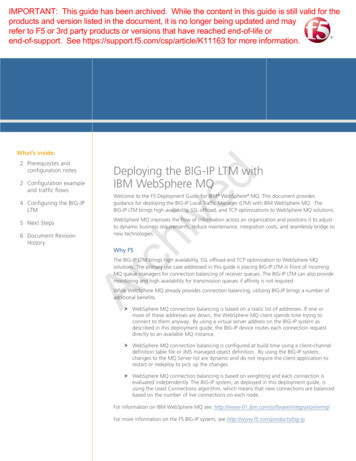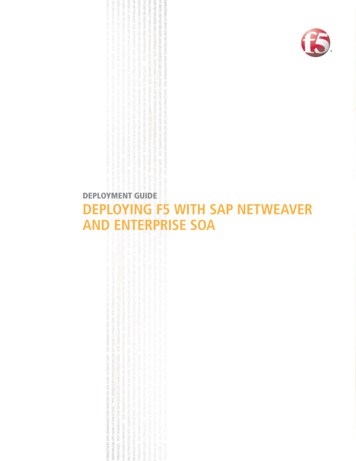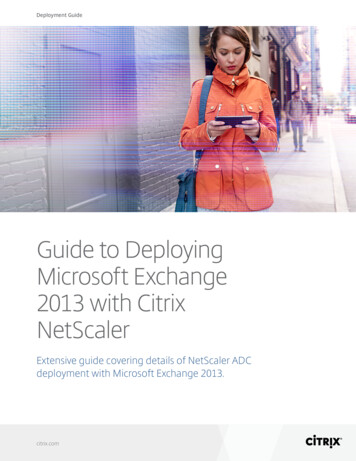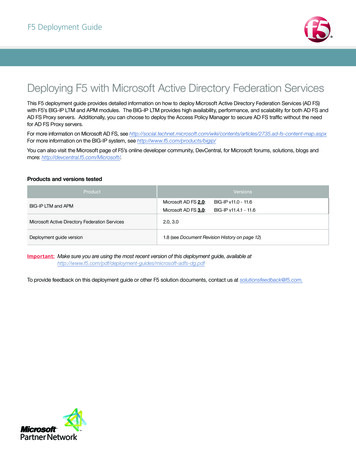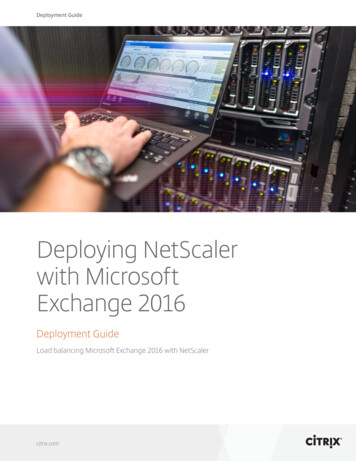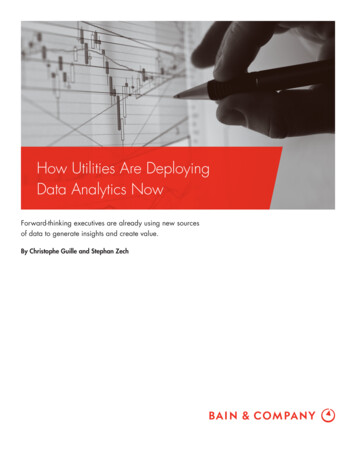
Transcription
How Utilities Are DeployingData Analytics NowForward-thinking executives are already using new sourcesof data to generate insights and create value.By Christophe Guille and Stephan Zech
Christophe Guille is a manager with Bain & Company in San Francisco, andStephan Zech is a partner in Bain’s Los Angeles office. Both work with Bain’sGlobal Utilities practice.Copyright 2016 Bain & Company, Inc. All rights reserved.
How Utilities Are Deploying Data Analytics Nowidentification of an issue) and better management of performance.Utilities are sitting on a wealth of opportunity fromdata analytics, with more information than ever beforeflowing from smart meters and other sensors, alongwith traditional sources of data about their operations.Most utility executives see the potential to mine thisdata for insights, even if they aren’t quite sure how orwhere to start. They know these discoveries will eventually generate tremendous value for their organizations, but they tend to think this will be years away, afterenormous investments to enhance systems and improvethe quality of data. The good news is, they don’t need to wait. Utilities already have access to data and tools that they can use tobegin deploying production analytics and generatinginsights that create value. They are improving theirability to analyze data and understand their business.For example, some have already sharpened their accuracyin predicting equipment failures and power-outagedurations—results that can reduce costs and increasecustomer satisfaction.Sizing up the analytics opportunityUtilities can get started by viewing the Big Data opportunity in terms of the complexity of the data and theanalytics capabilities the organization can bring tobear. It’s helpful to think about three levels of progression—basic descriptive systems, moderately complexpredictive systems, and more advanced prescriptivesystems—as a way of setting aspirations and developingstrategic plans to build up capabilities that will helputilities achieve their data goals (see Figure 1). Utilitieswon’t have to reach the highest levels of complexityand capability before seeing returns on their efforts.There is plenty of value to be mined in the mediumgray areas of the figure.These are just a few of the many ways that utility executives are exploring how to use new sources of data toimprove their operations, develop topline opportunitiesand strengthen relationships with customers. Theseexecutives are targeting several key areas for early exploration and success, including: Customer engagement. Data analytics can helputilities understand customers and their energyuse better—knowledge that utilities can useto design new products and services, such asdemand-side management programs that reduceelectricity use at peak times. Analytics also allowutilities to provide more accurate information tocustomers about power outages, grid updates,and repair work by field crews, all of which canraise customer satisfaction.Cost reduction. Analytics can help large utilitiesincrease capital productivity and save millions inoperations and maintenance expenditures by helpingthem improve operations (which can reduce callcenter volumes or help manage vegetation alongtheir power lines), optimize capital deployment(by identifying the most efficient ways to reducerisk) or understand their procurement better (weighingspending against value).In addition to the usual difficulties faced in so manyindustries—hiring and retaining good data-sciencetalent, breaking down siloed functions to acceleratelearning from insights, retraining existing staff to usedata and insights better—utilities have some uniquequalities that can make it particularly challenging toexpand analytics capabilities. For example, their currentdata systems have been set up to facilitate operations,and the data is often low quality and unstructured.Consider the historical data output from an outagemanagement system, which may be a simple log withtext notes indicating when events occurred. Such systems may not capture or retain all the details aboutcauses, duration or resolution, or they may capturethem in a format that’s not conducive to assembling aReliability. Advanced analytics can also help boostreliability dramatically by preventing outagesthrough more accurate predictions about whento replace failing equipment, or improving outage response through situational awareness (forexample, automated dispatch through real-time1
How Utilities Are Deploying Data Analytics NowFigure 1: Analytics can perform tasks ranging from simple descriptions to more complex capabilitiesthat predict outcomes or help determine which actions to takePrescriptivePredictiveMidlevel analytics offer insighton risks to operations and thepotential for outages or othertypes of failuresDescriptiveComplex decision making(e.g., understandingdrivers of performance inoutage response)Real-time integrateddecision making(e.g., automatedcrew dispatch)Basic prediction modelbased on limited data sets(e.g., basicrestoration-time forecast)Multivariable statisticalprediction models(e.g., advancedrestoration-timeforecast)Real-time integratedprediction(e.g., outage causeprediction)Reporting(e.g., dashboard)Basic data-drivendecision making(e.g., traditionalasset-allocation model)Real-time comprehensivecross-data exploration(e.g., utility-level outage mapleveraging smart meters)Basic data-drivendecision making(e.g., traditionalasset-allocation model)Analytics complexity algorithm objectiveThe most sophisticatedanalytics capabilities gobeyond monitoring systemsand equipment, and makerecommendations forpreventative or optimizingactionsBasic analytics give a view ofoperational and financialperformance, throughdashboards or even real-timemaps that use sensor andsmart-meter data to showusageData complexityReportingTraditionalanalyticsSource: Bain & Companylarge, mineable data set. A more advanced systemwould capture all this data in structured form, whichcompanies could compile and compare more easily.However, even with simple logs, utilities can use analytical methods to mine otherwise unstructured datasets and formulate valuable with data-savvy talent that brings advanced analytics,modeling and visualization skills to bear on these efforts.Quick win: How analytics assist with outagemanagementUtilities should start by picking a key objective or subject area and developing targeted analytics to build momentum. Such areas may include outage processes,materials management, demand-side management orasset analytics. Focusing on a single area can help inseveral ways.As their analytics capabilities evolve, utilities willneed to adopt more rigorous standards for capturing,storing and managing data. Cleaning up data is amajor challenge, requiring painstaking work to rationalize what is frequently a haphazard collectionof systems and restructuring them along commonlines so they can share and effectively use the dataat hand.Utilities will also have to get better at adopting andemploying advanced modeling techniques to discoverinsights in the data. Along with this task, utilities arebeginning to complement their existing workforces2 First, it focuses the organization on exploring advanced analytics, but within the framework of asingle design issue, with fewer stakeholders thanit will need as the programs broaden. Second, the initial data engineering represents theheavy lifting that can produce results elsewhere in
How Utilities Are Deploying Data Analytics Now the organization. Once data sets have been cleanedup and merged, additional and more advanced applications for the data can proceed quicker.can now filter the view by time of day, type of crew andlocation to review operations and find ways to increasereliability and reduce costs.Finally, a single effort can begin to generate momentum, and the organization can apply the lessons learned to future projects.Using advanced analytical techniques, the utility alsowas able to normalize differences across work locations and determine what processes and business rulesaffected the duration of each step. This effort helped itprioritize process-improvement initiatives, based ontheir value potential.One integrated utility decided to focus first on usingbetter analytics to resolve power outages more quickly,a case that applies to all three areas of exploration mentioned above: reducing costs, improving reliability, andpromoting customer engagement. The utility knew theaverage duration of power outages, but wasn’t surewhy some outages lasted longer than others or how itcould restore power sooner. By mining the data in itsoutage-management system and adding data sourcessuch as telematics, asset-location data and weather, itproduced a finer-grained view of its outage processesand the length of time taken for each step to restorepower (see Figure 2). Field supervisors and managersThe utility used this data to build predictive modelsthat delivered better forecasts of restoration times andgave customers more accurate information—a criticalcomponent of utility customer satisfaction. By addingvariables to estimation models and using more advanced statistical methods, the utility doubled the accuracy of its outage-duration forecasts and found newways to tell customers when power was likely to be restored, further strengthening customer engagement(see Figure 3).Figure 2: Analytics combined with GPS data gave a more detailed view of the time each step takes tocorrect power outagesMedian time it takes to restore powerExisting viewOutage durationView after mining outage dataDispatching first responderResponder traveling and workingCrew dispatchingCrew traveling and workingView with outage and GPS dataDispatching first responderResponder travelingResponder workingCrew dispatchingCrew travelingCrew workingSource: Bain & Company3
How Utilities Are Deploying Data Analytics NowFigure 3: Adding variables improved the accuracy of predictions of how long power outages would lastVariableOld modelNew modelPercentage of outages accurately predicted within stated rangeEquipment typeRegion2–3X improvementWeatherRepair statusSpread of outageHour of dayCustomers affectedDay of weekConcurrent incidentsMonth of yearOld modelSource: Bain & CompanyA new relationship with dataNew modelMost companies will need to secure quick wins usingexisting data and off-the-shelf analytical tools. Fromthese initial explorations, they will begin to build uptheir capabilities and extend their growing expertiseto more of their business. Their journey maytake years, but the benefits are sizable: millions ofdollars in value that would not be possible withoutadvanced analytics.Just as the widespread adoption of computerizedspreadsheets in the 1990s unlocked new ways to understand and manipulate data, so too does the currentexplosion in new data tools and analytical techniquespromise to elevate utilities’ understanding about theiroperations and customers. The first important step inunlocking that value is for utility executives to realizethe current potential of analytics and experiment withthe tools they already have.Some leading utilities and other industrial companieshave begun their journey by creating small centers ofexcellence within their organizations, tasked with advanced analytics projects. These teams typically combineskills from the business with more advanced data-sciencecapabilities. Once teams are in place, they help raisethe bar for analytics in the company, identifying andacting on opportunities with the highest potential value.4
Shared Ambit ion, True ResultsBain & Company is the management consulting firm that the world’s business leaders cometo when they want results.Bain advises clients on strategy, operations, technology, organization, private equity and mergers and acquisitions.We develop practical, customized insights that clients act on and transfer skills that make change stick. Foundedin 1973, Bain has 53 offices in 34 countries, and our deep expertise and client roster cross every industry andeconomic sector. Our clients have outperformed the stock market 4 to 1.What sets us apartWe believe a consulting firm should be more than an adviser. So we put ourselves in our clients’ shoes, sellingoutcomes, not projects. We align our incentives with our clients’ by linking our fees to their results and collaborateto unlock the full potential of their business. Our Results Delivery process builds our clients’ capabilities, andour True North values mean we do the right thing for our clients, people and communities—always.
Key contacts in Bain’s Global Utilities practiceAmericasMatt Abbott in Los Angeles (matt.abbott@bain.com)Neil Cherry in San Francisco (neil.cherry@bain.com)António Farinha in São Paulo (antonio.farinha@bain.com)Jason Glickman in San Francisco (jason.glickman@bain.com)Mark Gottfredson in Dallas (mark.gottfredson@bain.com)Joseph Herger in San Francisco (joe.herger@bain.com)Pratap Mukharji in Atlanta (pratap.mukharji@bain.com)Tina Radabaugh in Los Angeles (tina.radabaugh@bain.com)Rodrigo Rubio in Mexico City (rodrigo.rubio@bain.com)Joseph Scalise in San Francisco (joseph.scalise@bain.com)Bruce Stephenson in Chicago (bruce.stephenson@bain.com)Jim Wininger in Atlanta (jim.wininger@bain.com)Stephan Zech in Los Angeles (stephan.zech@bain.com)Asia-PacificSharad Apte in Bangkok (sharad.apte@bain.com)Wade Cruse in Singapore (wade.cruse@bain.com)Miguel Simoes de Melo in Sydney (miguel.simoes-demelo@bain.com)Amit Sinha in New Delhi (amit.sinha@bain.com)Europe,Middle Eastand AfricaAlessandro Cadei in Milan (alessandro.cadei@bain.com)Julian Critchlow in London (julian.critchlow@bain.com)Volkan Kara in Istanbul (volkan.kara@bain.com)Arnaud Leroi in Paris (arnaud.leroi@bain.com)Olga Muscat in London (olga.muscat@bain.com)Robert Oushoorn in Amsterdam (robert.oushoorn@bain.com)Kim Petrick in Dubai (kim.petrick@bain.com)Timo Pohjakallio in Helsinki (timo.pohjakallio@bain.com)Jacek Poswiata in Warsaw (jacek.poswiata@bain.com)For more information, visit www.bain.com
(e.g., utility-level outage map leveraging smart meters) Analytics complexity algorithm objective Data complexity based on limited data sets (e.g., basic restoration-time forecast) Figure 1: Analytics can perform tasks ranging from simple descriptions to more complex capabilities that


